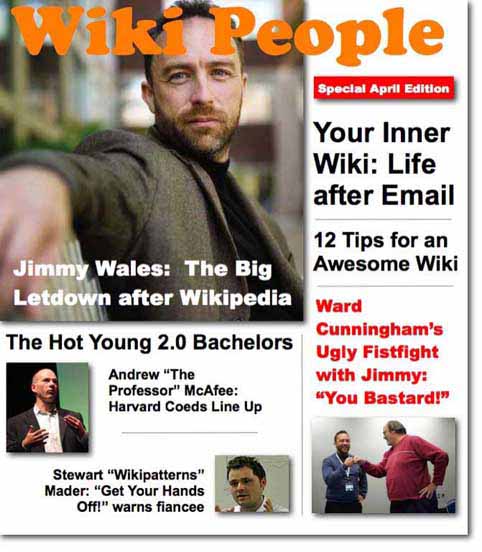
In spite of the delayed affect this economy seems to be having on technology, investors have no doubt, hence the market reaction. What does this mean for customers? What should one do differently when buying software? Part of my focus here is on Enterprise 2.0 and Web 2.0 software, but the advice generally applies.
Here are 5 tips for those buying during a weak economy…
1. Be a Cheap Bastard
Regardless of the economy, I come to the table biased: Software is generally way too expensive. Now, any bias doesn’t matter. Customers, who have budgets, will have greater buying power.
This is a story that repeats itself: Eighteen months ago the CEO of a new search technology start-up demoed his product to me. When I asked how much he would charge, he responded, “As much as possible.” This is a behavior that is commonplace; it is rooted in hiring expensive sales people and meeting unrealistic investor expectations. Today, this fellow would not get funding. Today, his VC would tell him to lower his prices and try a new marketing strategy.
Ingrained behaviors in enterprise software companies don’t die easily, so look for software where the value is compelling. This software may be all your CFO supports in the next year.
2. Focus on Project Teams and Content
(This is where I piss off the social media and Web 2.0 crowd). In the Enterprise 2.0 software space, a lot is made of social networking. Andrew McAfee‘s definition of Enterprise 2.0 includes the word “social”. Yet when times get tough, the core work is all we’ll care about because we’ll have fewer people to do the work. The core work is not my social network, it is my project, and the content we build every day. By core, I mean: what I need 90% of the day that leads to a real outcome.
Ned Lerner of Sony Playstation said something interesting at Enterprise 2.0 in Boston last June, he said, “We don’t worry about getting the next person motivated to join the large corporate social network, we worry about great tools for our project teams.” He focuses on how to make his projects productive.
When the chips are down and budgets are low, this type of practical thinking will dominate, because all CIOs and CFOs will care about is whether or not a tool really increases productivity, and helps the next high priority project.
It’s not that the social aspects of this new software are useless. Quite the contrary. It’s that the Doubting Eyes of Skeptics in your company will glaze over if you trumpet the personal pages and social connections in this wonderful new software. Your ability to search on who uses certain tags won’t get people jumping up and down.
As an example, you instead should be demonstrating how project teams can produce documentation for customers on the web site without any expensive software, and (if you like) customers will be able comment on it, or (if you like) edit and improve it. The difference is the focus on content.
3. Focus on Killer Apps – Obviously Useful Tools.
Email and Word processing are considered killer apps because their benefit is obvious and they spread rapidly. Obviously Useful Tools don’t need a Return on Investment (ROI) analysis. They don’t need a seminar on adoption. A $100K piece of traditional enterprise software rarely is a killer app because adoption invariably requires considerable work: convincing users, training, roll-out projects, and the Famous Dreaded ROI Study.
Blogs have been so popular, they are a killer app. I would classify blogging as a Tier Two Killer App simply because they are nowhere near as pervasive as say, office apps. Nonetheless, blogging has proved an extremely useful communication vehicle.
Wikis also earn this distinction. Thousands of people in companies are now using wikis, without training courses, management edicts, and ROI studies. The value wikis play in communities, collaboration, and knowledge capture is clear.
A practical test: ask how concrete or vague is the description of the software. I still don’t know what a Collaboration Platform really is, let alone a Scalable Enterprise one. If a vendor concentrates on the concrete usefulness at a tool level, then you have a) a better chance of understanding it, and b) eliminated a blizzard of marketing bullshit.
If one takes as a given that securing a new budget for a large software purchase will be hard for many CFOs to swallow in this economy, then concentrating on inexpensive, highly useful tools is the way to go.
4. Ask the Vendor a lot of Hard Questions
Although Oracle’s financial strength won’t be doubted, half or more of Silicon Valley should be. VCs take enormous risks, but is your CFO interested in this type of risk right now?
I am not advocating shutting out small companies. Instead, if you focus on truly useful tools (Tip #3) and you are a Cheap Bastard (Tip #1), then you are most of the way home here. How much can you lose on a $1,000 or 3,000 system?
Still, ask hard questions about the company’s performance and about their approach to doing business. How transparent are they? Transparency removes doubt about with whom you’re dealing. The honest, open small vendor with a useful, inexpensive tool might serve you better than the (seemingly) safe, expensive, traditional, Cloaked-in-Confidential-Price-Lists traditional vendor.
5. Did I say: Be a Cheap Bastard?
Oh yeah, in case I forgot. Now’s a good time to be a World-Class Tightwad. I spend time regularly in Sydney and Amsterdam, homes of the Dutch and Australians, both world renowned for seeking value (I am being polite). Right now, make a practical Dutchman your role model when you belly up to the Software Bar. Cheers.







